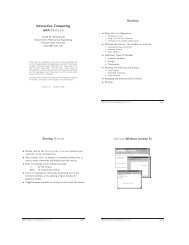"O Soul, Come Back!" A Study in The Changing Conceptions of The ...
"O Soul, Come Back!" A Study in The Changing Conceptions of The ...
"O Soul, Come Back!" A Study in The Changing Conceptions of The ...
You also want an ePaper? Increase the reach of your titles
YUMPU automatically turns print PDFs into web optimized ePapers that Google loves.
SOUL AND AFTERLIFE 393the newly dead would be required to report to the underworldgovernment <strong>in</strong> Kao-li <strong>in</strong> a way similar to the hun-soul's journey toLiang-fu. As a response to the rise <strong>of</strong> the popular cult <strong>of</strong> hsien immortality,which prevented the hun-soul from return<strong>in</strong>g to heaven, theCh<strong>in</strong>ese underworld seems to have been fundamentally restructuredalong a dualistic l<strong>in</strong>e to accommodate the hun and the p 'o respectively.This dualistic structure <strong>of</strong> the pre-Buddhist Ch<strong>in</strong>ese underworldis clearly reflected <strong>in</strong> the follow<strong>in</strong>g four l<strong>in</strong>es from a song aboutMount T'ai by the famous writer Lu Chi M (261-303):On the hill <strong>of</strong> Liang-fu there are hostels (kuan M),In Kao-li there are also lodges (t'<strong>in</strong>g *) for the travellers,Along the dark path stretch ten thousand ghosts (kuei),one follow<strong>in</strong>g the footsteps <strong>of</strong> another,In the spiritual houses (shen-fang 4Mi) are gathered hundreds<strong>of</strong> spirits (l<strong>in</strong>g X).78Here the poet is describ<strong>in</strong>g imag<strong>in</strong>ed scenes <strong>of</strong> the trips <strong>of</strong> both thehun-souls and the p 'o-souls to their separate dest<strong>in</strong>ations-Liang-fuand Kao-li. In his imag<strong>in</strong>ation the poet <strong>in</strong>troduces the Han system<strong>of</strong> travellers' <strong>in</strong>ns (kuan and t'<strong>in</strong>g) <strong>in</strong>to the underworld.79 <strong>The</strong>re canbe no question that the term kuei ("ghosts") refers specifically to thep'o-souls and the term l<strong>in</strong>g ("spirits") to the hun-souls. In a Confuciantreatise on the "Mean<strong>in</strong>g <strong>of</strong> Sacrifice" ("Chi-i" A) <strong>of</strong> Handate, kuei and shen are def<strong>in</strong>ed as the names <strong>of</strong> p 'o and hun respec-above make good sense if we keep <strong>in</strong> m<strong>in</strong>d that <strong>in</strong> Han times people generally believed notonly <strong>in</strong> the separation <strong>of</strong> the hun and the p 'o at death but also <strong>in</strong> the possibility <strong>of</strong> achiev<strong>in</strong>ghsien immortality and ascension to heaven. While contradictions and <strong>in</strong>consistencies are certa<strong>in</strong>lythere, they do not <strong>in</strong>validate or render mean<strong>in</strong>gless the cluster <strong>of</strong> Han beliefs we havebeen exam<strong>in</strong><strong>in</strong>g. On the contrary, there is every reason to th<strong>in</strong>k that these beliefs occupied acentral place <strong>in</strong> the daily life <strong>of</strong> Han Ch<strong>in</strong>ese irrespective <strong>of</strong> their social status. Moreover, asrecent religious studies <strong>in</strong> the West have shown, beliefs <strong>in</strong> heaven and the afterlife do not dependon logical consistency for their validity. On this po<strong>in</strong>t, see Robert N. Bellah, "Christianityand Symbolic Realism,' Journalfor the Scient ifc <strong>Study</strong> <strong>of</strong> Religion 9 (Summer 1970): 89-96, and Bradley R. Hertel, "Inconsistency <strong>of</strong> Beliefs <strong>in</strong> the Existence <strong>of</strong> Heaven andAfterlife," Review <strong>of</strong> Religious Research 21.2 (Spr<strong>in</strong>g 1980): 171-83.78 See Lu Shih-heng wen-chi d.1Ifi7V$ (SPTK edition), 7.28.79See Y<strong>in</strong>g-shih Yu, Trade and Expansion <strong>in</strong> Han Ch<strong>in</strong>a (Berkeley: University <strong>of</strong> CaliforniaPress, 1967), pp. 32-34.















